New Treatment for Macular holes
Recent approval of Jetrea (Ocriplasmin) to treat symptomatic VMA (Vitreo Macular Adhesion) has opened up a new era in non surgical management of macular holes. Previously only a hospital based surgery was able to reverse the process of macular hole development but now a new drug can be injected into the eye painlessly in the office and within a few weeks the process reverses back to more normal vision levels.... more
FDA Approves ASRS Leader's ArgusŪ II Artificial Retina
On February 14, the FDA approved the Argus II artificial retina developed by ASRS Executive Committee and Board Member Mark S. Humayun, MD, PhD.
This breakthrough technology is the first ever to offer limited vision to patients with late-stage retinitis pigmentosa (RP).
Second Sight Medical Products (Sylmar, CA) manufactures the Argus II implant, which has 60 electrodes and a tiny camera mounted on eyeglasses to capture images.
The FDA approved Argus II for adults age 25 years or older with severe to profound RP. About 10,000 to 15,000 of the 100,000 Americans with RP will qualify for Argus II. Up to 4,000 patients a year can be treated with the device.
Macular degeneration and Aspirin?
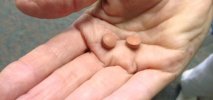
Aspirin and Macular degeneration... is there an increase in the wet form of macular degeneration in those patients taking aspirin? The wet form develops quicker than the dry form. It may only be related to the fact that you are more likely to take aspirin if you have medical problems like stroke or heart attacks in the past and these conditions are more commonly associated with wet age related macular degeneration. ... more

Macular Degeneration (Wet & Dry Forms)
Overview:
The retina acts like the imaging chip in a digital camera, “taking a picture” of what you are seeing and then sending a message to your brain through your optic nerve so that it “knows” what you have seen. The macula is a part of the retina that helps detect the light and images that the retina sees. The macula is the reading and high resolution center of the vision. Macular degeneration, which largely occurs due to aging, involves the macula deteriorating, thereby causing the once-sharp images being seen to become increasingly blurry when looking at them straight on.
Symptoms & Types:
The most telling and most common symptom of (age-related) macular degeneration involves the loss of central or straight-on or reading vision. Typically, peripheral vision is unaffected, but those with macular degeneration find it very difficult to drive, read, identify faces, and make out details of objects. Patients have a harder time with the activities of daily living but do not go totally blind if surgery for macular degeneration is not done.
Dry Macular Degeneration
Dry Macular Degeneration (atrophic), occurs as a result of a thinning of the blood vessels under the macula therefore not delivering the nutrients that the macula needs to function. Nine out of ten cases of macular degeneration are dry. There may be minimal distortion but a slowly increasing difficulty in reading ability.
Wet Macular Degeneration
Wet Macular Degeneration (exudative) involves abnormal blood vessels growing in a layer beneath the retina, leaking blood and fluid that can create the blind spot in your vision by blistering the retina. This type of macular degeneration is typically more rapid onset and only occurs in one out of ten cases. There is a more blurring of the vision and distortion of the vision in one eye. Affected individuals would have to cover one eye at a time to test the vision as if both eyes are open when testing the vision, the brain will look at the best vision while the other eye gets worse unnoticed.
Treatments:
Testing the vision in both types:
Using an Amsler grid frequently to test the vision is vital to discovering when the macular degeneration becomes wet. Testing each eye one at a time by covering the other eye and looking at the Amsler grid and noticing if the lines are straight or crooked. New crooked or bent lines with new dark spots in the vision needs attention right away. A dilated eye exam with fluorescein angiography will be needed to decide a course of action.
Normal Amsler grid: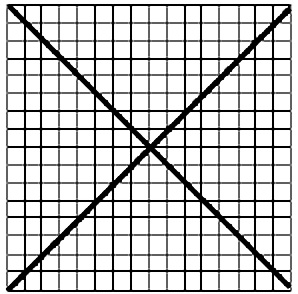
Some times as the retina develops dry changes it may look like this: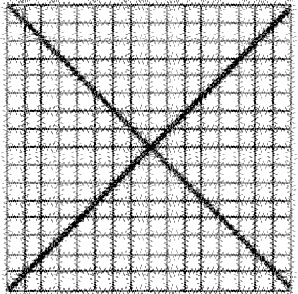
As the wet changes start to happen, it may look like this: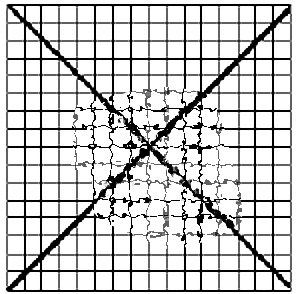
As the wet ARMD starts to bleed and cause distortion, it may look like this: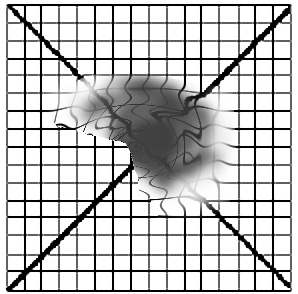
If the above Amsler grid looks anything like this then you may have wet macular degeneration and need attention soon.
Download a copy of the Amsler Grid here
Vitamin Intake:
Currently, the only treatment for dry macular degeneration is taking vitamins with zinc and lutein. Much research is being done to alter the course. Macular degeneration is related to smoking, high blood pressure, stroke and heart attacks. It stands to reason to control the blood pressure, stop smoking, do what is good for hardening of the arteries. These recommendations also slow down the wet type but is not a cure.
For Wet type:
If the new abnormal blood vessels are not growing directly beneath the central vision, laser surgery has proven to be an effective method to prevent further vision loss due to wet macular degeneration. The laser will leave a mark in the back of the eye that the patient may see as a dark spot in the vision. Unfortunately, there can be recurrence of the blood vessels in up to 50% of treated cases, therefore checking the vision and frequent eye exams are needed. On occasions combined treatment of laser and Avastin injection may reduce the recurrence.
Photodynamic Therapy:
If the abnormal blood vessels are growing directly beneath the macula, these patients may be candidates for photodynamic therapy (PDT) to minimize side effects experienced by other forms of treatment. This is a special drug injected in to a vein of the arm and when the drug reaches the eye vessels, a low powered laser activates the drug and this closes all the blood vessels centrally. This has fallen mostly out of use by it’s self as recurrence is common and the end result is likely to be an atrophic central scar with poor vision.
Intravitreal Injections:
Currently, the treatment standard for Wet Macular Degeneration involves injecting special medications directly into the eye that target the hormone Vascular Endothelial Growth Factor (VEGF). VEGF causes the growth of abnormal blood vessels that then leak serum and bleed under the macula. The stimulus for the production of VEGF is poor blood flow (ischemia) of the normal blood vessels under the retina. There are several types of VEGF: #165 is found in highest concentration in the eye, #121 is found to help new blood vessels in the heart overcome a heart attack. There are drugs that take out all subtypes of VEGF (Lucentis, Avastin, Eylea) and others only take out #165 (Macugen). The drugs that take out all the VEGF seem to get more vision to return than the specific type of drug. The treament protocols are evolving rapidly to get the best long term results. Check the blog for new information as it changes. Read more.
This treatment has been quite effective in managing Wet Macular Degeneration and may potentially help to improve vision as well. The most used drug nation wide is Avastin. Others include Lucentis, Macugen, Eylea (the latest drug to be cleared by the Food and Drug Administration). Recent drug studies have shown that at the very least Avastin is as effective as Lucentis and has possibly less systemic side effects. it also is the most cost effective. Eylea has recently been released however there have recently been 14 cases of an infection like reaction to the drug in the first 3 months since it's release. It also has not been shown to be better than Avastin.
Prevention:
Although age and heredity are important risk factors for developing macular degeneration, having blue eyes, high blood pressure, cardiovascular disease, and smoking put individuals at risk as well.
Avoid smoking and limit exposure to second hand smoke (as in living with a heavy smoker who smokes in the house). To keep cholesterol at a healthy level, maintain a diet low in saturated, trans fats and animal fats, but high in fiber (at least 20g daily). Eat at least five servings of fruits and/or vegetables daily and drink plenty of water. Do what is considered to be good for your heart heath.
Take the vitamins and zinc as this slows the progression and delays the change from dry to wet macular degeneration. Monitor an Amsler grid so that you can detect the change from dry to wet and get an eye exam as soon as possible if that occurs.
Click Here to Read an Article About Nutritional Therapy that May Help ARMD






